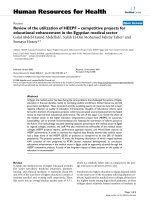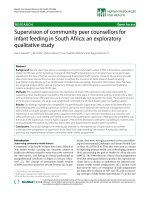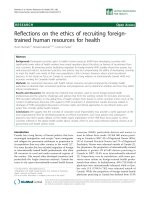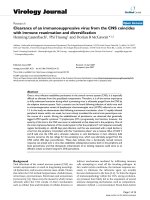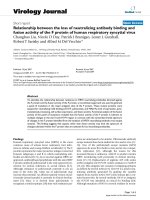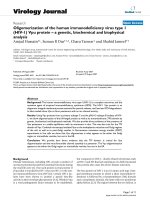báo cáo sinh học:" Review of the utilization of HEEPF – competitive projects for educational enhancement in the Egyptian medical sector" potx
Bạn đang xem bản rút gọn của tài liệu. Xem và tải ngay bản đầy đủ của tài liệu tại đây (234.24 KB, 8 trang )
BioMed Central
Page 1 of 8
(page number not for citation purposes)
Human Resources for Health
Open Access
Review
Review of the utilization of HEEPF – competitive projects for
educational enhancement in the Egyptian medical sector
Galal Abdel-Hamid Abdellah
1
, Salah El-Din Mohamed Fahmy Taher
2
and
Somaya Hosny*
3
Address:
1
HEEPF National Committee, Egypt,
2
Higher Education Enhancement Project Fund, HEEPF, Egypt and
3
Suez Canal University, Egypt
Email: Galal Abdel-Hamid Abdellah - ; Salah El-Din Mohamed Fahmy Taher - ;
Somaya Hosny* -
* Corresponding author
Abstract
In Egypt, the medical sector has been facing the same problems that challenged the system of higher
education in the past decades, mainly an increasing student enrollment, limited resources, and old
governance and bylaws. These constraints and the escalating paucity of resources have had a major
negative influence on quality of education. Consequently, thoughts of educational reform came
forward in the form of competitive projects, which have attracted several institutes from the health
sector to improve their educational performance. The aim of this paper is to review the share of
the medical sector in the higher education enhancement project fund (HEEPF), its outcomes,
sustainability, and to provide recommendations for keeping the momentum of reform pursuit in
the future. The methodology included obtaining statistics pertaining to the medical sector in Egypt
as regards colleges, students, and staff. We also reviewed the self-studies of the medical sector
colleges, HEEPF projects reports, performance appraisal reports, and World Bank reports on
HEEPF achievements in order to retrieve the required data. Results showed that medical sector
had a large share of the HEEPF (28.5% of projects) as compared to its size (8% of student
population). The projects covered 10 areas; the frequency distribution of which ranged between
4.4% (creation of new programs) to 97.8% (human resource development). In conclusion,
educational enhancement in the medical sector in Egypt could be apparently achieved through the
HEEPF competitive projects. A study of the long-term impact of these projects on the quality of
education is recommended
Review
In Egypt, the medical sector of higher education includes
five major specialties; medicine, pharmacy, dentistry,
nursing, and physical medicine. It represents about 8%
and 36% of the total force of higher education in terms of
students enrolled and working staff, respectively. Thus,
this sector has an average student teacher ratio of 9.5:1,
which is a relatively better ratio as compared to the aver-
age total ratio in all sectors (39.8:1) [1].
Enrolment into higher education in Egypt depends solely
on the total score of the secondary school graduation cer-
tificate. Applicants for medical sector colleges always have
the highest marks among high school graduates, as these
colleges admit relatively limited numbers of students in
Published: 18 April 2008
Human Resources for Health 2008, 6:7 doi:10.1186/1478-4491-6-7
Received: 15 November 2007
Accepted: 18 April 2008
This article is available from: />© 2008 Abdellah et al; licensee BioMed Central Ltd.
This is an Open Access article distributed under the terms of the Creative Commons Attribution License ( />),
which permits unrestricted use, distribution, and reproduction in any medium, provided the original work is properly cited.
Human Resources for Health 2008, 6:7 />Page 2 of 8
(page number not for citation purposes)
comparison to other sectors. Medical sector colleges have
still a highly prestigious outlook and corroborate certified
opportunities at national and regional job markets; this
renders them a target for the highest achieving students
[2].
Education in the medical sector is offered via three rela-
tively independent bodies; public secular, public reli-
gious, and private. The public secular body contains 49
colleges in which 116 326 (79.7%) students are enrolled.
The private body includes 13 colleges in which 19 942
(13.7%) students are registered, while the religious body
(Al-Azhar University) has 10 colleges which have a total of
9601 (6.6%) students, according to data of academic year
2004–2005 [1].
Because the public secular body of the medical sector has
the largest share in terms of students' enrolment (see Fig-
ure 1), it became the main target of the educational
enhancement projects funded by the World Bank and the
Egyptian government.
Problems and challenges facing education in the medical
sector
The system of higher education in Egypt has been facing a
number of problems and challenges during the last dec-
ades. This situation that led to a state of low system effi-
ciency was previously addressed and analyzed [3,4].
Besides the typical problems of overcrowding, limited
financial resources, lack of a sustainable financial policy,
inadequate infrastructure, under-trained faculty members
in some areas, poor instructional materials and equip-
ment and lack of a formal evaluation and accreditation
mechanism, a number of other problems have emerged in
the era of rapid explosion of information and modern
communication technology. This latter group of problems
can be summarized as follows:
• The enormous advances in information/communica-
tion technology (ICT) and its application to all activities
including the teaching/learning process and academic
administration constitute a major challenge to higher
education due to the emerging need for changing the way
of developing and delivering educational materials and
services. It has also created a continuous need to update
ICT and associated skills, and an increasing need for dis-
Distribution of students' enrolment in the three bodies of the medical Sector (Academic year 2004/2005)Figure 1
Distribution of students' enrolment in the three bodies of the medical Sector (Academic year 2004/2005).
79.7
13.7
6.6
0.0
10.0
20.0
30.0
40.0
50.0
60.0
70.0
80.0
90.0
100.0
%
Public secular
Private
Public religious
Human Resources for Health 2008, 6:7 />Page 3 of 8
(page number not for citation purposes)
tance learning. Furthermore, incoming students increas-
ingly have high ICT competencies, and consequently
expect consistent ICT facilities in their higher education.
• The continuing emergence of new discoveries adding to
the core of knowledge calls for a parallel enhancement of
all aspects of relevant competencies of workforce, includ-
ing knowledge, attitude and skills. Also pertinent here is
keeping abreast with changes in how knowledge is certi-
fied.
• Increased competition with greater numbers of higher
education providers (public, private & corporate) compet-
ing for student enrolment and resources.
• Increased global competition for top students, especially
with availability of distance education opportunities and
virtual universities.
Similar issues were identified in more details and more
hands-on experience when individual faculties in the
medical sector carried out their self-studies to perform an
assessment of the current status in their pursuit for accred-
itation. In these studies, some of the faculties have
adopted the WFME standards in basic medical education
as their reference standards [5]. The most important prob-
lems/needs identified by these colleges include:
• The undergraduate curricula need review and reform [6-
9].
• There is a need for introducing new courses based on
recent advances in science, and on identified community
needs [9,10].
• Faculty members need more training in curriculum
planning, teaching and assessment methods, and other
aspects of medical education [6,7,11].
• The process of resource allocation should be adequately
revised in order to ensure enough resources for educa-
tional reform[6,8,9].
• Substantial resources have to be allocated to upgrade
libraries and ICT facilities with an emphasis on computer-
assisted learning [7,9,11].
• There is a marked deficiency of lab equipment due to
insufficient funds, at both undergraduate and research
levels [8,10,11].
• The educational program needs comprehensive
repeated evaluation in order to ensure continuous
improvement and self correction [6,7,11].
• The total budget allocated to research activities is very
limited with no contribution from private sectors in
research budget [6,10].
• There is no complete updated database for faculty con-
tributions in scientific conferences, and for their publica-
tions in conferences and periodicals [6,7].
• Capacity building and developmental programs for
non-academic administrative staff are lacking [8,9,11].
• Many clinical departments have no skills labs, e.g., sur-
gery, emergency [8].
• There is a need for practical training of students on use
of IT in self-learning, accessing information, etc [11].
• Undergraduate students are seldom involved in research
[7-9].
• Didactic learning dominates clinical training, practical
skill development, self learning and problem solving
[6,7,9].
Higher education enhancement projects (HEEP)
Higher education reform in Egypt started in the early
1980s. However serious budget constraints hampered
achieving the objectives of that reform [12]. More
recently, a strategy for education reform was established,
and the reform agenda was influenced by the National
Conference on Higher Education, held in February 2000.
Its major aim was to redress Egypt's need to upgrade edu-
cational quality in the university sector [13].
In April 2002, The World Bank approved a US$ 50 million
loan to support Egypt's initiative to improve the higher
education system in the country through Higher Educa-
tion Enhancement Project (HEEP). This project is part of
the comprehensive strategy for education reform in Egypt
[13] The HEEP focuses on three central areas: a) improv-
ing the efficiency through the reform of governance and
management of the higher education system; b) improv-
ing the quality and relevance of university education to
respond to the needs for new learning technologies,
equipment, and human resource development; and c)
improving quality and relevance of mid-level technical
education [14].
The HEEP six priority projects are Higher Education
Enhancement Project Fund (HEEPF), Information and
Communications Technology Project (ICTP), Egyptian
Technical Colleges Project (ETCP), Faculty of Education
Project (FOEP), Faculty Leaders Development Project
(FLDP), Quality Assurance, and Accreditation Project
(QAAP) [15]. The medical sector faculties submitted pro-
Human Resources for Health 2008, 6:7 />Page 4 of 8
(page number not for citation purposes)
posals in mainly two out of the six projects of the HEEP,
namely HEEPF and QAAP.
The Higher Education Enhancement Project Fund (HEEPF)
in the medical sector
The HEEPF started in 2003 aiming at assuring the compet-
itive potentiality of higher education institutions and sup-
porting decentralization and administrative autonomy in
order to achieve progress in quality, efficiency, and effec-
tiveness in higher education systems and institutions. The
objectives of the HEEPF are: a) creating a competitive
atmosphere that helps in the development of higher edu-
cation institutions (departments/faculties/universities);
b) encouraging decentralization and autonomy of educa-
tional institutions and the continuous self development
of the educational process; c) enhancing the potentials of
academic institutions for the development and establish-
ment of modern scientific specializations; d) strengthen-
ing the cooperation and integration between industry and
higher education institutions; e) developing Management
Information Systems (MIS); and f) increasing the sources
of information, preparing laboratories, and organizing
their usage [15].
HEEPF financed 158 projects in different faculties and
institutions of the public secular universities with a total
budget of US$13 million. The share of the medical sector,
in the four cycles of the project, was 45 (28.5%) out of the
158 projects (see Figure 2). They are distributed as follow-
ing; 33 for medicine, 3 for pharmacy, 3 for dentistry and
6 for nursing schools. Thus, it is clear that the medical sec-
tor has a large stake in these competitive projects (45
projects for 49 colleges). Within the medical sector, col-
leges of medicine have got the lion's share (33 projects for
14 colleges) [15]. This might reflect the strong feelings of
the medical staff regarding the need for reform.
Outcomes of HEEPF projects
The broad areas targeted by HEEPF projects in the medical
sector and the numbers of projects in each area are shown
in Table 1. It is obvious that almost all projects are not
limited to only one area, but are rather targeting several
areas at the same time. This comprehensive approach in
facing various aspects of problems at the same time is
more effective than dealing with each separately.
The area of human resources development was addressed
in most of the projects (97.8%). This shows how projects'
managers value the human factor in any developmental
process, and recognize it as a principal component in their
plans. The target population (human resources) involved
students, faculty members, administrators and/or techni-
cians. This comprehensiveness reiterates that achievement
of any progress is not dependent on a single professional
category of people but it is a joint effort of all categories of
workers in the medical sector.
Slightly less than half of the projects (44.4%) were con-
cerned with developing courses or curricula for the under-
graduates or postgraduates. These were aiming at
improving the quality of education by fostering innova-
tive approaches like community-based education, pri-
mary care, problem-solving skills, evidence-based
medicine, and research methodology. Some of them con-
centrated on technical and administrative aspects. Others
emphasized the practical and clinical skills, hospital safety
measures, emergency and first aid measures, instrumental
analysis, and clinical pharmacy.
Share of the medical sector projects in HEEPFFigure 2
Share of the medical sector projects in HEEPF.
Medical
sector
28.5%
Others
71.5%
Medical sector
Others
Human Resources for Health 2008, 6:7 />Page 5 of 8
(page number not for citation purposes)
Computer assisted learning and computer aided teaching
techniques were emphasized in one third (33.3%) of the
projects. All five specialties of the medical sector partici-
pated in this area. The developed learning materials varied
between electronic animated teaching courses, electronic
interactive instructional modules, online courses and
electronic books, imaging archives, computer-based eval-
uation forms, video conference for live transmission of
surgical procedures and scientific events, multimedia
video-films for different clinical skills, and electronic
media for analytical problems [16].
New teaching techniques/methodologies, including new
assessment tools, were developed by slightly less than one
third (31.1%) of the medical sector projects. The new
methodologies were stressing intellectual, presentation,
clinical, surgical, computer skills, and clinical compe-
tence. Knowledge and attitude learning domains were
taken care of in some of the developed teaching tools [17].
Training and specialized centres were established by
31.1% of the medical sector projects in different fields.
These included information technology, X-ray, infection
control, disaster medicine, medical education, evidence-
based medicine, life-saving and life support, maintenance
of medical equipment, early diagnosis of disabilities,
endoscopic surgery, burn management, and dental care.
All the established centres are offering training and educa-
tion for undergraduates and postgraduates, and/or serv-
ice. Collaboration between institutions and community
non-governmental organizations (NGOs) was achieved in
those centres [17].
The area of information technology (IT) was tackled by
13.3% of the projects. They applied IT in establishing
database and electronic libraries for labs, departments,
hospitals, or setting up network connections between dif-
ferent places inside or outside institutions [15].
One of the principles of learning is elaboration on infor-
mation [18], which means obtaining information from
different resources. This principle was achieved through
providing different knowledge resources by some
projects, mainly in the medicine specialty of the medical
sector (8.9%)
Although QAAP is one of the six projects of the HEEP,
8.9% of the medical sector projects of the HEEPF
addressed the area of quality assurance and management
to get ready for accreditation. Those projects were mainly
conducted by medicine and nursing colleges. This impor-
tant area is supposed to be addressed by almost all schools
in Egypt, later on, through the QAAP.
Establishing labs, museums and virtual labs was targeted
by 8.9% of the projects. The aims of those labs were
enhancing research, teaching large numbers of students,
performing surgical procedures, in addition to analytical
processes. Introduction of new programs was done by
only two projects (4.4%). These were also in the medicine
specialty, and both were for postgraduates. Their fields
were medical education and community medicine, which
are very important and demanding fields.
Additional outcomes for the medical sector projects were;
developing websites, publications, establishing computer
labs and building bridges with other institutions through
integration programs [15].
Integration of the HEEPF projects
One of the main objectives of HEEPF is strengthening
cooperation among projects of institutes of higher educa-
tion. Hence, integration was fostered to achieve maxi-
mum collaboration between projects in the same specialty
(horizontal integration) and between projects in the same
faculty and/or university (vertical integration).
Table 1: Areas targeted by HEEPF projects in the medical sector
Targeted areas* Number of projects (n = 45)
No. %
Human resource development 44 97.8
Curriculum/course development 20 44.4
Computer-assisted learning 15 33.3
New teaching techniques-methodologies 14 31.1
Establishing training and specialized centers 14 31.1
Information technology 6 13.3
Knowledge resources 4 8.9
Quality assurance and management 4 8.9
Establishing labs/museums/virtual Labs 4 8.9
New programs 24.4
(*) Not mutually exclusive
Human Resources for Health 2008, 6:7 />Page 6 of 8
(page number not for citation purposes)
The objectives of the integration in the medical sector
were clear-cut: a) acquaintance and awareness among the
different projects b) studying potentials and methods of
integration between activities of different projects c) inte-
grating possible dissemination and sustainability plans
among projects d) Formation of a core management team
with a representative from each project. Several activities
were organized to achieve these objectives, including
inauguration of fixed meetings, a workshop, and develop-
ing templates for integration of activities [19].
Products of this integration included a) dissemination of
objectives of projects, its activities and the outcomes
among participating bodies. b) exchange of knowledge
and experience among faculty members of the same col-
lege, as well as, colleges of other universities. c) adding
more beneficiaries d) exchange of some deliverables and
resources e) creating more links and collaboration
schemes among projects which assure sustainability [17].
Quality control of the HEEPF projects
HEEPF was keen to apply quality control measures
throughout duration of projects in order to ascertain high
quality of the implemented activities and their outcomes.
Monitoring mechanisms included internal auditing,
external auditing, as well as local and foreign peer review-
ing. Examples of the tools and techniques used by medical
sector projects for quality control measures include ques-
tionnaires for evaluation of the products by all beneficiar-
ies, pre/post tests, assessment of utilization of materials,
in addition to reference standards for courses or curricula.
Self-evaluation reports of the management and imple-
mentation teams about their work were also submitted as
quality control documents [20].
Assessment of performance of HEEPF projects
Regular assessment of performance of the projects was
done by the HEEPF monitoring team. The criteria used for
assessment were [20]:
• Outcomes are matching objectives
• Activities are done in time
• Quality of outcomes in terms of preparation, execution,
cost and time
• Indicators of success were approached
• Methods of dissemination and quality control measures
were taken care of
• Sustainability
• Suitability of the setting and venue of the project to the
activities
• Extent of utilization of requested equipments
• Proficiency of the management team
According to the used criteria of assessment, performance
of the HEEPF projects of the medical sector was shown to
be very high and the projects' rating ranged between very
good and excellent.
Sustainability of HEEPF projects
The issue of sustainability of projects is a major concern to
HEEPF. The continuity of the projects in serving students,
schools, universities, other institutions, and communities
is one of the HEEPF main targets. Regular follow-up visits
were rendered by HEEPF monitoring team to projects sites
to make sure there is sustainability. Many sustainability
mechanisms were achieved by the medical sector projects,
which can be summarized as follows [17,20]:
• Setting up agreements with other institutions to dissem-
inate outcomes of the projects. The medical sector was the
second sector (after the science sector) among the HEEPF
projects to develop those agreements. The agreements
held by the medical sector projects were done with non-
governmental organizations, other universities, ministry
of health, syndicates, hospitals and private schools.
• Establishing self-sustained special units, which can be
self-financed. The medical sector ahead of other sectors in
this respect.
• Submitting proposals for other funding agencies to
expand or execute another phases of the project. Some
medical sector projects submitted proposals to TEMPUS
(Trans-European Mobility Scheme for University Studies)
and most of these have been approved.
Impact assessment of HEEPF projects
The overall goal of impact assessment is to identify
whether HEEPF projects have efficiently achieved their
planned goals and to assess its impact on the reform of
higher education. The study of impact assessment of the
HEEPF projects is still going on; the current phase is deal-
ing with outcome assessment related to implementation
of projects rather than long-term impact assessment [21].
Problems encountered during the management of HEEPF
As a part of the self assessment process of the HEEPF,
some problems and weaknesses were recorded by the
management team [22]; some examples are as follows:
Human Resources for Health 2008, 6:7 />Page 7 of 8
(page number not for citation purposes)
• The lack of quantitative studies of needs assessment in
most of the participating faculties, before the commence-
ment of the projects, has deprived the selection process of
an important determinant criterion.
• Insufficient coordination in the management of the
HEEP big six projects resulted in some overlap between
HEEPF projects' activities and other projects' activities
such as QAAP.
• Lack of enthusiasm of some individual projects' manag-
ers for the required integration with the other related
projects has resulted in suboptimal utilization of mutu-
ally available resources.
• The dissemination of the projects achievements and its
role in educational enhancement was relatively lagging,
and was not done through a well-planned system of mar-
keting.
• Inability of some projects managers to provide sustaina-
bility plans that depend on partnership between the uni-
versity resources and the private sector.
• Inability or lack of enthusiasm of some institutes to par-
ticipate in HEEPF has deprived some universities from a
real chance to enhance their education
The extent to which HEEPF projects responded to the
problems and challenges of higher education in the
medical sector
Although the HEEPF for the medical sector did not cover
all colleges, 45 projects for the 49 colleges of the medical
sector is a figure which can certainly have an impact on
some of the educational problems. The main and major
problem identified by the medical sector, which is "con-
strained financial resources", has been greatly sur-
mounted by the funding made available for these projects.
This helped solving defined problems such as inadequate
infrastructure, lack of modern technology, and poor
instructional materials and equipment. Overcoming these
problems should have an impact on the quality of educa-
tion. The problem of under-trained faculty members and
non-academic administrative staff was successfully
addressed by almost all projects. About half of the projects
responded to the problem of inadequate and insufficient
courses, curricula and programs. Curriculum develop-
ment and reform, of course, is a great pillar in the educa-
tion reform. The problems of lack of database, computer
facilities, computer-assisted materials and online learning
were also dealt with by about half of the projects. This,
likely, would improve the quality of teaching and might,
indirectly overcome the problem of increased numbers of
students. The problems of insufficient students' clinical
training and lack of practical training on IT were also
addressed by many projects, which would ultimately help
providing the community with more proficient graduates.
Although the problem of lack of accreditation mecha-
nisms was entertained by some projects, it still needs
more effort from the QAAP.
Meanwhile, some of the problems in the medical sector
did not get the required priority in HEEPF projects. The
problem of inadequate level of scientific research is an
example. This is probably related to the complex nature of
this problem, and the fact that some of its aspects are
beyond the scope of the HEEPF, e.g., the limited national
fund for research.
Conclusion
The medical sector has benefited much from the HEEPF
both quantitatively and qualitatively. It obtained 45 out
of the total 158 projects (28.5%), with a sum total of 3
596 326 out of the 13 million US$ (27.7%) budget allot-
ted to all projects. This is an enormous share in view of the
relatively small size of this sector, which hosts only 8% of
the total students enrolment within the Egyptian system
of higher education. This disproportionately large contri-
bution reflects the bad need of this sector for reform
projects due to its special nature as it deals with human
health, and depends greatly on practical training which
requires many trained human resources and extensive
infrastructure.
The projects of the medical sector have covered ten areas
of education enhancement that addressed the common
problems identified in the self-studies done by several col-
leges in this sector. The most commonly targeted areas are
human resource development (97.8%), curriculum/
course development (44.4%), and computer-assisted
learning, together with information technology (46.6%
for both together). The least commonly targeted areas
were creating new programs (4.4%), new labs (8.9%),
knowledge resources (8.9%), and quality assurance sys-
tems (8.9%). The areas which have been addressed in a
fair frequency are developing new teaching techniques
(31.1%) and establishing training centres (31.1%),
This frequency distribution of the addressed areas proba-
bly reflects the relative weight of perceiving the defined
problems. Some areas were infrequently addressed in
spite of their importance e.g. quality assurance, this may
be due the presence of a separate project for quality
(QAAP), in which all colleges in this sector would eventu-
ally participate
The projects of the medical sector as well as those in other
sectors were continuously monitored, integrated with
each other both vertically and horizontally, and are
planned to be self-sustainable.
Human Resources for Health 2008, 6:7 />Page 8 of 8
(page number not for citation purposes)
In order to make use of the lessons learnt in this round,
the following recommendations can be concluded from
this study:
1. Competitive projects represent a suitable way for edu-
cational reform as they are funnelled to the neediest sec-
tors and the most needy colleges; thus they should remain
a continuous policy in higher education reform.
2. There is a need for a quantitative assessment of the
problems and challenges facing the medical sector in
order to plan and evaluate the future projects accordingly.
3. Completing the study of the impact assessment of the
projects and ensuring its wide dissemination should be
emphasized.
4. The results of long-term follow-up of sustainability of
the projects should be critically appraised, published and
disseminated in order to improve sustainability in future
rounds.
5. Colleges should be encouraged to involve more stake-
holders such as non-governmental organizations and
industrial sector in these competitive projects.
6. Allowing marketing of the tangible products of the
projects among different governmental institutions as a
means to support the sustainability is strongly recom-
mended and will constitute a moral incentive for the col-
leges and institutions.
7. Encouraging the institutions which did not share in the
first round to participate in the next one through technical
support by a team of experts.
8. Involving the public religious (Al Azhar) body in the
HEEPF is suggested as it is supported by the government
and suffers from similar problems of the medical sector.
9. Involving the private body in partnership with the pub-
lic body in conjoint projects can ensure a high quality of
education in this private body, which represents 13.7% of
the medical sector
10. Encouraging projects that address computer-assisted
learning and online education.
11. Special projects should be planned by the HEEPF to
boost research activities.
Competing interests
The authors declare that they have no competing interests.
Acknowledgements
The authors are indebted to the support of the Ministry of Higher Educa-
tion to conduct this research. Thanks are due to the entire HEEPF team and
sub-projects managers who contributed to adopting such a dynamic sys-
tem. The contribution of Dr. M. E. Said, Director of the Project Manage-
ment Unit (PMU) through the implementation process is highly
appreciated. Thanks are due to Prof. Yasser El-Wazir and Dr. Maha
Rashwan for their valuable contribution to this manuscript. The revision of
the manuscript by Prof. Assem Al-Sherif and Prof. Adel Mishriky is also
highly appreciated.
References
1. Supreme Council of Universities, "Statistical Data about
University Education in Egypt," Department of Statistics.
2006. (pamphlet)
2. General rules for admission to the Egyptian colleges & insti-
tutions 2007 [
].
3. EL-Mahdy M: Ministry of Higher Education (MOHE), Higher
education in Egypt. 2001 [ />grammes/tempus/countries/higher/egypt.pdf].
4. El Sebai NM: The Egyptian Higher Education System:
Towards Better Quality in the Future. Journal of Futures Studies
2006, 11(2):75-92.
5. Basic Medical Education: WFME Global Standards for Quality
Improvement. WFME Office: University of Copenhagen Denmark;
2003.
6. Self-study: Faculty of Medicine, Cairo University; 2004.
7. Self-study: Faculty of Medicine, October 6th University; 2005.
8. Self study: Faculty of medicine, Alexandria university; 2005.
9. Self study, Faculty of medicine, Zagazig university; 2006.
10. Annual self evaluation report: Faculty of Pharmacy, Helwan Univer-
sity; 2005.
11. Self-study: Faculty of Medicine, Suez Canal University; 2005.
12. Richard A: Higher education in Egypt; population and human
resources department, the world bank. 1992.
13. Middle east & north Africa region (MENA)-Egypt, Country
brief, World Bank Group 2006 [B-
SITE/EXTERNAL/COUNTRIES/MENAEXT/
EGYPTEXT0,,menuPK:287166~pagePK:141132~piPK:141107~theS
itePK:256307,00.html].
14. Egypt: Higher Education Enhancement Project 2007
[http:b.worldbank.org/WBSITE/EXTERNAL/PROJECTS/0,,content
MDK:20040415~men
uPK:64282138~pagePK:41367~piPK:279616~theS-
itePK:40941,00.html].
15. Main objectives, about HEEPF, Higher Education Enhance-
ment Project Fund 2006 [ />].
16. HEEPF Specialized Booklet Series – 9 Parts, HEEPF Publications 2007.
17. Evaluation of HEEPF and Future Prospective-Phase I Documentation,
HEEPF Publications 2007.
18. deWinstanly PA, Bjork RA: Successful lecturing: Presenting
information in ways that engage effective processing. In D. F.
Halpern & M. D. Hakel (Eds.), New Directions in Teaching and Learning
(no. 89) Applying the Science of Learning to University Teaching, San
Francisco: Jossey-Bass; 2002:19-32.
19. Integration of the Higher Education Enhancement Projects
Fund, Medical sector integration document, unpublished
data. 2006.
20. HEEPF performance appraisal by Egyptian universities,
HEEPF publications, Part 1. 2007.
21. HEEPF impact assessment, Higher Education Enhancement
Project Fund 2007 [ />].
22. HEEPF performance appraisal, Higher Education Enhance-
ment Project Fund 2007 [ />impact].
